武汉理工大学国际贸易专业国际商务10级复习提纲
国际商务10 期末总复习

课程内容汇总
第一章 第二章 第三章 专题 第四章 第五章 第六章 第七章 导论 国际商务理论与政策 国际商务环境 国际目标市场选择 国际经营方式 国际经营战略 国际商务组织 国际企业管理
导论
1. 什么是国际商务?它有哪些经营形式? 2. 何谓经济全球化?经济全球化具体表现在哪些方面? 其推动因素有哪些?
跨国运营--营销和生产
1. 制定国际产品策略主要考虑哪几方面? 2. 国际产品标准化策略或差异化策略选择的影响因素有 哪些? 3. 产品定价方法有哪些? 4. 对比国际分销策略的三种类型。 5. 试比较国际营销中各种促销手段:广告、营业推广、 人员推销、公共关系各自的优缺点。 6. 为什么跨国公司大多实行全球采购? 7. 简述影响企业全球生产选址决策的因素。 8. 你认为构建和整合供应链的关键方面是什么?
跨国运营——财务
1. 国际财务管理包括哪些内容? 2. 简述国际商务活动中的融资方式。 3. 何谓转移定价?国际企业为什么采用转移价格? 4. 跨国公司如何利用转移价格转移利润?请举例说明。 5. 何谓国际双重征税?简述国际双重征税产生的原因及 解决的办法。 6. 跨国公司有哪几种避税方法? 7. 试述外汇风险的类型及外汇风险管理的方法。
战略
运营
理论
导论 理论
目标市场 营销
经营方式 生产 全球战略 财务
组织结构 人力资源
Source: John D. Daniels and Lee H. Radebaugh, International Business, 8th ed., Reading MA: Addison-Wesley, 1998, p. 10
7. 何谓国际目标市场定位?国际目标市场定位有哪些主要 方式?
《国际商务专业基础》考试大纲

434 ----《国际商务专业基础》考试大纲一、基本要求要求考生理解国际贸易产生的原因以及国际贸易对一国经济乃至世界经济的影响;掌握国际贸易的主要理论与政策;掌握关税、非关税壁垒等贸易措施及其对商品的价格、生产、消费和国家福利水平所带来的影响;能够运用相关贸易理论、分析工具和方法来分析和解决国际贸易及国际商务中的实际问题。
二、考试范围本课程考试内容要求分为四个层次:识记:能知道有关的名词、概念、知识的含义,并能正确认识和表述;领会:在识记的基础上,能全面把握基本概念、基本原理,能掌握有关概念和原理的区别与联系;简单应用:在领会的基础上,能用学过的一两个知识点分析和解决简单的问题;综合应用:在简单应用的基础上,能用学过的多个知识点,综合分析和解决较复杂的问题。
1.导论识记:国际贸易;国际分工;全球化;绝对优势;比较优势;重商主义等基本概念。
领会:国际贸易理论发展经历的阶段;国际贸易相关概念;国际贸易的基本分类;国际贸易的基本经济分析工具和方法;绝对优势论的主要内容;重商主义的主要观点。
2.劳动生产率与比较优势识记:生产可能性边界;机会成本;贸易得益等基本概念。
领会:李嘉图模型的基本假设;比较优势论的主要内容。
简单应用:只有一种要素的封闭经济下本国与外国的生产、相对价格和均衡。
综合应用:运用基本经济分析工具和方法分析开放经济下的生产、贸易和均衡;掌握贸易后国际相对价格的确定,并分析贸易得益。
3.要素禀赋与比较优势识记:要素密集度;丰裕要素;稀缺要素;生产可能性边界的偏向扩张;斯托尔帕—萨缪尔森定理;赫克歇尔----俄林定理;要素价格均等化定理;列昂惕夫之谜等基本概念。
领会:H-O模型的基本假设;要素禀赋论的主要内容;S-S定理、FPE定理的主要内容;列昂惕夫之谜。
简单应用:运用相关理论解释现实的国际贸易现象。
综合应用:根据要素密集度、要素丰裕度来分析基于要素禀赋理论的国际贸易模式,并理解交换得益和资源再分配得益。
国际商务总复习要点归纳

国际商务教学幻灯片提要第一章全球化全球化:含义:指转向一个更为一体化和相互依存的世界经济表现:市场的全球化(分离的国家市场合并为一个巨大全球的市场.不同国家的消费者的嗜好和偏爱正在趋向与某些全球标准.)生产的全球化(企业从各地区筹供商品和服务,以利用各国在生产要素上的成本和质量的差异,降低企业生产的总成本构成以及改善他们提供产品的功能,而达到更有效的参与竞争的目的),全球机构的出现(帮助管理,规范和监督全球市场,促使多国协议的制定来治理全球商务秩序)国际化,全球化,一体化三者间区别?经济国际化是指一国经济发展超越国界,与别国经济的相互联系、相互渗透不断扩大和深入的经济发展过程。
经济全球化是指各种经济资源在世界范围内日益广泛和深入地进行自由流动和“合理”配置的过程,从而出现世界各国的经济联系日益加深,是世界各国经济相互间高度依赖和融合的表现。
经济一体化的含义有广义和狭义之分。
广义的经济一体化,即世界经济一体化,或称全球经济一体化,它指各国国民经济之间彼此相互开放,取消歧视,形成一个相互联系、相互依赖的有机整体。
狭义的经济一体化,即地区经济一体化,或称区域经济一体化,区域经济集团化,是指两个或两个以上的国家或地区间不断消除或降低彼此间经济政策与体制差异,相互依存、共同发展经济的过程。
全球化的驱动力:不断降低的关税及贸易壁垒,技术变革,跨国公司的兴起全球化的争议:就业与收入,劳工政策和环境问题,国家主权问题,世界上的穷国国际商务:为满足个人以及组织需求而进行的跨国界的商务活动国际商务研究的是跨越国界的商务活动,即以国家或企业为主体以实现某种经济目标而进行的经济活动。
商务的含义:以实现商品或服务的交易而开展的一系列的经营管理活动。
与相关概念的区别:商业:专门从事商品流通的行业贸易:各种商品买卖行为市场营销:商品供给主体实现市场销售的各种活动国际商务环境政治体制:民主制:纯民主制度,代议民主制度特点:言论自由,定期选举,完全公民与财产权,少数民族的权利,非政治性官僚机构极权制度:神权极权主义和世俗极权主义。
国际贸易期末考试复习大纲核心知识点整理
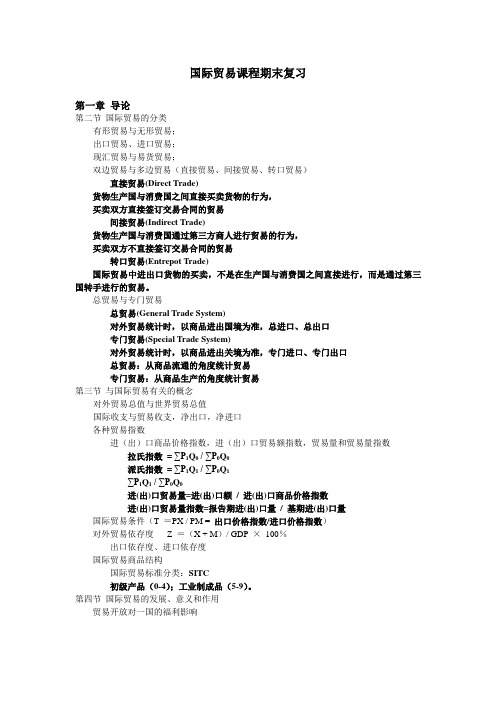
国际贸易课程期末复习第一章导论第二节国际贸易的分类有形贸易与无形贸易;出口贸易、进口贸易;现汇贸易与易货贸易;双边贸易与多边贸易(直接贸易、间接贸易、转口贸易)直接贸易(Direct Trade)货物生产国与消费国之间直接买卖货物的行为,买卖双方直接签订交易合同的贸易间接贸易(Indirect Trade)货物生产国与消费国通过第三方商人进行贸易的行为,买卖双方不直接签订交易合同的贸易转口贸易(Entrepot Trade)国际贸易中进出口货物的买卖,不是在生产国与消费国之间直接进行,而是通过第三国转手进行的贸易。
总贸易与专门贸易总贸易(General Trade System)对外贸易统计时,以商品进出国境为准,总进口、总出口专门贸易(Special Trade System)对外贸易统计时,以商品进出关境为准,专门进口、专门出口总贸易:从商品流通的角度统计贸易专门贸易:从商品生产的角度统计贸易第三节与国际贸易有关的概念对外贸易总值与世界贸易总值国际收支与贸易收支,净出口,净进口各种贸易指数进(出)口商品价格指数,进(出)口贸易额指数,贸易量和贸易量指数拉氏指数= ∑P1Q0/ ∑P0Q0派氏指数= ∑P1Q1/ ∑P0Q1∑P1Q1/ ∑P0Q0进(出)口贸易量=进(出)口额/ 进(出)口商品价格指数进(出)口贸易量指数=报告期进(出)口量/ 基期进(出)口量国际贸易条件(T =PX / PM = 出口价格指数/进口价格指数)对外贸易依存度Z =(X + M)/ GDP ×100%出口依存度、进口依存度国际贸易商品结构国际贸易标准分类:SITC初级产品(0-4);工业制成品(5-9)。
第四节国际贸易的发展、意义和作用贸易开放对一国的福利影响第二章传统国际贸易理论第一节国际分工的形成和发展初始形成发展深化水平分工、垂直分工、混合型、外包、网络分工等;影响当代国际分工的主要因素:社会生产力自然条件人口/劳动力规模与市场资本国际化国际生产关系经贸政策ES N ES E E P第二节重商主义货币,即金银贵金属(noble metal)就是财富;商业尤其是对外贸易,是一个国家创造与增殖金银财富的最有效途径;国家应当对货币流通和商品贸易采取严格的管制。
《国际贸易》总复习提纲
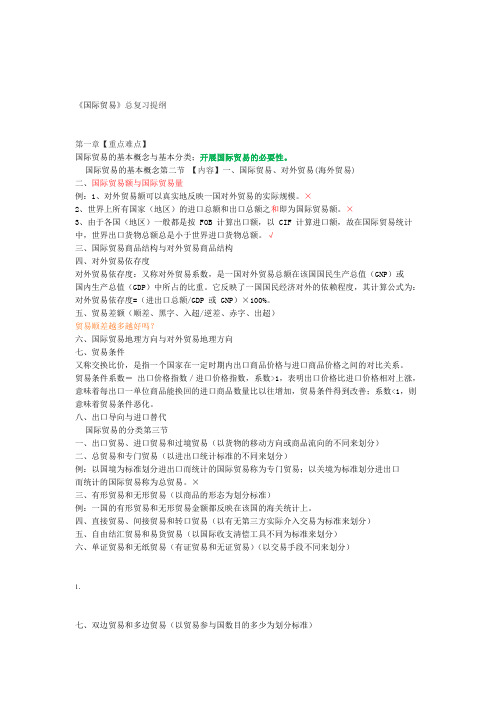
《国际贸易》总复习提纲第一章【重点难点】国际贸易的基本概念与基本分类;开展国际贸易的必要性。
国际贸易的基本概念第二节【内容】一、国际贸易、对外贸易(海外贸易)二、国际贸易额与国际贸易量例:1、对外贸易额可以真实地反映一国对外贸易的实际规模。
×2、世界上所有国家(地区)的进口总额和出口总额之和即为国际贸易额。
×3、由于各国(地区)一般都是按FOB计算出口额,以CIF计算进口额,故在国际贸易统计中,世界出口货物总额总是小于世界进口货物总额。
√三、国际贸易商品结构与对外贸易商品结构四、对外贸易依存度对外贸易依存度:又称对外贸易系数,是一国对外贸易总额在该国国民生产总值(GNP)或国内生产总值(GDP)中所占的比重。
它反映了一国国民经济对外的依赖程度,其计算公式为:对外贸易依存度=(进出口总额/GDP或GNP)×100%。
五、贸易差额(顺差、黑字、入超/逆差、赤字、出超)贸易顺差越多越好吗?六、国际贸易地理方向与对外贸易地理方向七、贸易条件又称交换比价,是指一个国家在一定时期内出口商品价格与进口商品价格之间的对比关系。
贸易条件系数=出口价格指数/进口价格指数,系数>1,表明出口价格比进口价格相对上涨,意味着每出口一单位商品能换回的进口商品数量比以往增加,贸易条件得到改善;系数<1,则意味着贸易条件恶化。
八、出口导向与进口替代国际贸易的分类第三节一、出口贸易、进口贸易和过境贸易(以货物的移动方向或商品流向的不同来划分)二、总贸易和专门贸易(以进出口统计标准的不同来划分)例:以国境为标准划分进出口而统计的国际贸易称为专门贸易;以关境为标准划分进出口而统计的国际贸易称为总贸易。
×三、有形贸易和无形贸易(以商品的形态为划分标准)例:一国的有形贸易和无形贸易金额都反映在该国的海关统计上。
四、直接贸易、间接贸易和转口贸易(以有无第三方实际介入交易为标准来划分)五、自由结汇贸易和易货贸易(以国际收支清偿工具不同为标准来划分)六、单证贸易和无纸贸易(有证贸易和无证贸易)(以交易手段不同来划分)1.七、双边贸易和多边贸易(以贸易参与国数目的多少为划分标准)八、水平贸易和垂直贸易(以参与国经济发展水平差异为划分标准)第二章【重点难点】古典国际贸易理论即亚当·斯密与绝对优势理论和大卫·李嘉图与比较优势理论的现代经济模型分析方法;机会成本递增下的国际贸易。
国际贸易复习提纲..
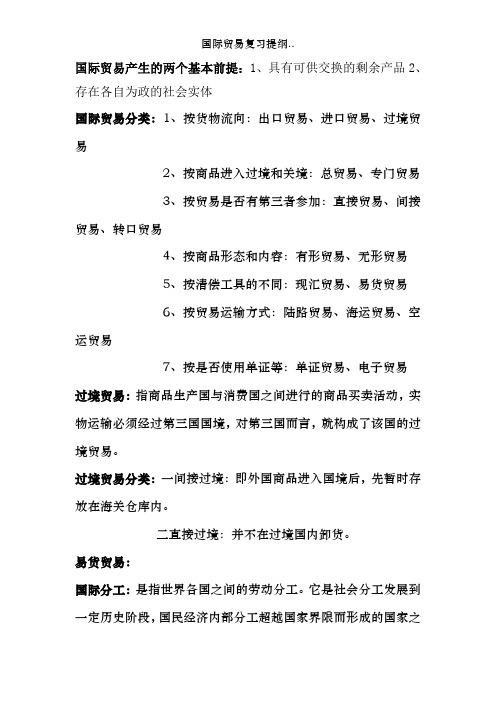
国际贸易产生的两个基本前提:1、具有可供交换的剩余产品2、存在各自为政的社会实体国际贸易分类:1、按货物流向:出口贸易、进口贸易、过境贸易2、按商品进入过境和关境:总贸易、专门贸易3、按贸易是否有第三者参加:直接贸易、间接贸易、转口贸易4、按商品形态和内容:有形贸易、无形贸易5、按清偿工具的不同:现汇贸易、易货贸易6、按贸易运输方式:陆路贸易、海运贸易、空运贸易7、按是否使用单证等:单证贸易、电子贸易过境贸易:指商品生产国与消费国之间进行的商品买卖活动,实物运输必须经过第三国国境,对第三国而言,就构成了该国的过境贸易。
过境贸易分类:一间接过境:即外国商品进入国境后,先暂时存放在海关仓库内。
二直接过境:并不在过境国内卸货。
易货贸易:国际分工:是指世界各国之间的劳动分工。
它是社会分工发展到一定历史阶段,国民经济内部分工超越国家界限而形成的国家之间的分工。
第一章1、绝对优势理论:处于工场手工业向大机器工业过度时期亚当·斯密—基本思想:每一个国家都应该生产具有绝对优势的产品去交换本国必需的但自己生产又处于绝对不利地位的产品,从而使本国的土地、劳动和资本得到最有效的利用,提高劳动生产率,增加社会财富。
2、比较优势理论:英国革命深入发展时期大卫.李嘉图—基本思想:在国际分工中,如果两国生产力不等,甲国生产任何一种商品的成本均低于乙国,处于绝对优势;而乙国的劳动生产率在任何商品的生产中均低于甲国,处于绝对劣势,这时两国仍存在进行贸易的可能性,即遵循“两优相权取其重,两劣相权取其轻”的原则。
3、要素禀赋理论():赫克歇尔、俄林要素禀赋:是指一个国家或一个地区各种生产要素的供给状况或对生产要素的拥有状况。
基本思想:(1)一国出口的应是使用本国相对充裕的生产要素生产的产品,进口的应是本国相对稀缺的生产要素生产的产品。
(2)在自由贸易条件下,国际间的商品流动不仅会使各国商品价格均等化,而且会使各国的生产要素价格趋于均等化,即要素价格均等化。
大学国际商务复习资料

大学国际商务复习资料大学国际商务复习资料随着全球化的不断深入,国际商务已成为大学商学院中一门重要的课程。
对于学习国际商务的学生来说,复习资料是提高考试成绩的关键。
本文将为大家提供一些关于国际商务的复习资料,帮助大家更好地掌握这门课程。
一、国际贸易理论国际贸易理论是国际商务的基础,了解和掌握相关理论对于理解国际商务的运作机制至关重要。
其中,比较优势理论、绝对优势理论和新贸易理论是学习国际贸易理论的重点。
1. 比较优势理论比较优势理论是由经济学家大卫·李嘉图提出的,它认为各国在生产某种商品上具有不同的比较优势,应该专注于生产自己的比较优势商品,然后通过国际贸易来获取其他商品。
这个理论解释了为什么国际贸易会带来互利互惠的效果。
2. 绝对优势理论绝对优势理论是由亚当·斯密提出的,它认为某个国家在生产某种商品上具有绝对优势,即该国可以以较低的成本生产该商品。
这个理论解释了为什么国际贸易中有些国家能够以较低的价格出口商品。
3. 新贸易理论新贸易理论是20世纪80年代提出的,它认为国际贸易的发展不仅仅是由比较优势和绝对优势所决定,还受到产品差异化、规模经济和垄断力量等因素的影响。
这个理论解释了为什么国际贸易中有些国家能够出口高附加值的产品。
二、国际市场分析国际市场分析是国际商务中的重要环节,它涉及到了市场需求、市场规模、市场竞争等方面的内容。
在进行国际市场分析时,可以采用PESTEL分析和SWOT 分析等方法。
1. PESTEL分析PESTEL分析是对国际市场宏观环境的分析,它包括政治、经济、社会、技术、环境和法律六个方面。
通过对这六个方面的分析,可以了解国际市场的整体环境,为企业的国际业务决策提供参考。
2. SWOT分析SWOT分析是对国际市场微观环境的分析,它包括企业的优势、劣势、机会和威胁四个方面。
通过对这四个方面的分析,可以了解企业在国际市场中的竞争优势和面临的挑战,从而制定相应的国际市场策略。
国贸本科《国际商务谈判与礼仪》复习提纲.doc

2010级国贸本科《国际商务谈判与礼仪》复习提纲1 •题型单选15题判断15题多选10题名词解释10题论述2题2.重点、1、国际商务谈判是以经济效益作为谈判的主要评级指标。
P22、国际商务谈判既是一笔交易的商洽,也是一项涉外活动,具有较强的政治性。
卩23、根据参加谈判的利益主体数量不同,可以将谈判分为双方谈判和多方谈判。
P44、根据谈判中双方所采取的态度,可以将谈判分为三种类型:让步型谈判,立场型谈判和原则型谈判。
P45、“三来一补”谈判中的“三來”指从国外來料加工,來样加工和來件装配业务;“一补”指补偿贸易。
P96、国际商务谈判的基本程序包括:准备阶段、开局阶段和正式谈判阶段。
P97、止式谈判是整个谈判过程的主体,一般要经历询盘、发盘、还盘和接受四个环节。
P108、国际商务谈判的基本原则包括:平等性廉则和互利性原则。
P119、在商务谈判中,双方地位平等是指双方在法律上的平等。
P1510、商务谈判的经济学理论主要讲述需求价格弹•性和需求收入弹•性。
P1811、马斯洛提出的人类行为基本要素的五种需求层次包括:牛理的需求,安全的盂求,社交的需求,尊重的需求和自我实现的需求。
P2012、在马斯洛的需求层次理论中,牛理需求是坟基本的需求。
P2013、美国著名律师、谈判学奠基人尼尔伦伯格将谈判划分为三个层次:自然人与自然人之间的谈判,自然人与法人之间的谈判,法人与法人之间的谈判。
P2114、尼尔伦伯格认为,在任何一种非个体的谈判小,往往都有两种需求在同时起作用:一种是谈判者所代表的法人的需求,另一种是谈判者的个体需求。
P2115、西方学者对谈判双方的输赢关系作了非常深入而系统的探讨,将谈判分为分配性谈判与整合性谈判。
P2216、谈判吋以规格作为产品的品质,并作为谈判条件,--般来说比较准确,所以大多数商品交易都采用这种方法。
P3417、在有商品标准的前提下,交易谈判时,只需说明商品的标准,就对以表达谈判双方对商品品质提出的要求。
国际商务英语考试商务知识必备知识点

国际商务英语考试商务知识必备知识点一、国际贸易基础知识国际贸易的定义:国际贸易是指不同国家、不同地区之间进行商品、服务和资本的交换和流通的经济活动。
国际贸易的形式:主要包括货物贸易、服务贸易和资本贸易。
国际贸易的参与主体:包括出口商、进口商、运输公司、报关行等。
二、国际支付与结算国际贸易中的支付方式:包括现金支付、信用证支付、托收支付、跨境电子支付等。
国际结算的方式:主要有电汇、信汇、票汇和汇票等。
国际贸易的结算货币:通常是以美元为主要结算货币,也有部分以欧元、人民币等其他货币结算。
三、国际物流与运输国际物流的定义:是指货物从生产地到销售地的整个运输和仓储环节。
国际物流的主要环节:包括采购物流、生产物流、销售物流和售后物流等。
国际运输方式:包括海运、空运、陆运和铁路运输等。
四、国际市场开拓与营销国际市场开拓的步骤:包括市场分析、目标市场选择、市场定位和市场推广等。
国际市场营销的策略:包括产品策略、价格策略、渠道策略和促销策略等。
五、国际贸易法律法规国际贸易的法律法规:包括WTO框架下的《关税及贸易总协定》(GATT),《国际货物销售合同公约》(CISG)等。
国际贸易合同的要素:合同主体、货物描述、价格条款、交货方式和付款方式等。
国际贸易纠纷解决方式:包括商业仲裁、诉讼和调解等。
六、国际商务礼仪与文化国际商务礼仪的重要性:在国际商务交往中,合适的商务礼仪能够提升商务合作的效果和信任度。
国际商务文化的差异:不同国家和地区的商务文化存在差异,了解并尊重对方的商务文化是成功经营国际业务的重要因素。
七、国际商务风险管理国际贸易的风险:包括汇率风险、物流风险、贸易壁垒和政治风险等。
国际商务风险管理的措施:包括货物保险、贸易融资、风险评估和合同管理等。
总结:以上所述为国际商务英语考试商务知识必备的知识点,深入了解和掌握这些知识对于成功应对国际商务考试和实际商务操作具有重要意义。
希望本文所提供的知识点对您有所帮助。
湖北省考研国际商务复习重点归纳与解析

湖北省考研国际商务复习重点归纳与解析第一章综述湖北省考研国际商务考试是考察考生在国际商务领域中的专业知识和能力的重要考试。
本章将对考试的目的、内容和形式进行综述,并介绍备考的重点和方法。
第二章国际贸易2.1 国际贸易的基本概念国际贸易是指不同国家之间进行的商品和服务的跨境交流和交易。
本节将对国际贸易的定义、特点以及国际贸易的意义进行阐述。
2.2 国际贸易的主体国际贸易的主体包括国际贸易公司、进出口代理商、跨国公司等。
本节将重点介绍各类主体的特点、职责及运作方式。
2.3 国际贸易的方式国际贸易的方式包括直接贸易和间接贸易。
本节将分析两种贸易方式的优缺点,并探讨其适用场景和操作步骤。
2.4 国际贸易的风险管理国际贸易中存在各种风险,如汇率风险、物流风险、信用风险等。
本节将介绍各类风险的特点和防范措施,以提高考生对风险管理的理解。
第三章国际金融3.1 国际金融的基本概念国际金融是指跨国经济活动中的货币和资金流动。
本节将对国际金融的定义、重要性和分类进行解析。
3.2 汇率制度汇率制度是指各国之间确定和维持汇率的制度安排。
本节将介绍主要的汇率制度,如固定汇率制度、浮动汇率制度等,并分析其优缺点。
3.3 国际金融市场国际金融市场是进行跨国货币和资金交易的市场,包括外汇市场、国际债券市场等。
本节将详细介绍各类国际金融市场的特点和功能。
3.4 国际金融体系国际金融体系是指各国之间的金融关系和机构的总体组合。
本节将探讨国际金融体系的演变、组成以及对国际金融的影响。
第四章国际商务法律4.1 国际商法的基本概念国际商法是调整国际商务活动中各类主体关系的法律规则和原则。
本节将解析国际商法的定义、特点和适用范围。
4.2 国际贸易合同国际贸易合同是国际贸易活动中约定各方权利和义务的法律文件。
本节将介绍国际贸易合同的要素、类型和起草要点。
4.3 国际支付方式国际支付方式是指进行跨国交易时所采用的资金支付方式,如信用证、托收等。
国际商务知识点
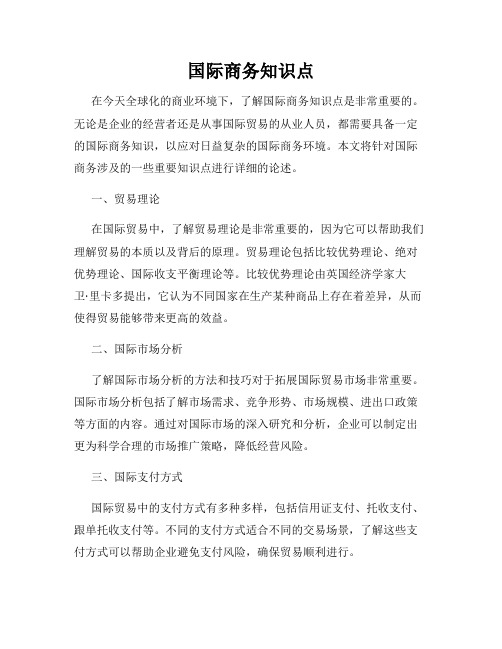
国际商务知识点在今天全球化的商业环境下,了解国际商务知识点是非常重要的。
无论是企业的经营者还是从事国际贸易的从业人员,都需要具备一定的国际商务知识,以应对日益复杂的国际商务环境。
本文将针对国际商务涉及的一些重要知识点进行详细的论述。
一、贸易理论在国际贸易中,了解贸易理论是非常重要的,因为它可以帮助我们理解贸易的本质以及背后的原理。
贸易理论包括比较优势理论、绝对优势理论、国际收支平衡理论等。
比较优势理论由英国经济学家大卫·里卡多提出,它认为不同国家在生产某种商品上存在着差异,从而使得贸易能够带来更高的效益。
二、国际市场分析了解国际市场分析的方法和技巧对于拓展国际贸易市场非常重要。
国际市场分析包括了解市场需求、竞争形势、市场规模、进出口政策等方面的内容。
通过对国际市场的深入研究和分析,企业可以制定出更为科学合理的市场推广策略,降低经营风险。
三、国际支付方式国际贸易中的支付方式有多种多样,包括信用证支付、托收支付、跟单托收支付等。
不同的支付方式适合不同的交易场景,了解这些支付方式可以帮助企业避免支付风险,确保贸易顺利进行。
四、国际物流管理国际物流管理是指在国际贸易过程中的物流运作和管理。
它包括国际货物运输、仓储管理、供应链管理等方面的内容。
对于拓展国际贸易市场和提高运营效率来说,合理的物流管理是至关重要的。
五、国际商务谈判国际商务谈判是指在国际贸易中进行的双方协商和讨价还价的过程。
有效的商务谈判可以帮助企业争取更多利益,并确保贸易关系的稳定和长久。
了解商务谈判的技巧和策略对于从事国际贸易的从业人员非常关键。
六、国际商务法律国际贸易涉及的国际商务法律非常复杂,如海关法、国际货物买卖合同、海事法等。
了解并遵守国际商务法律对于企业的合法经营和维护自身权益有着重要的意义。
七、国际商务道德国际商务道德是指在国际贸易中应遵循的基本道德规范和准则。
企业应该遵循诚信、公平竞争、履行契约等原则,保持与合作伙伴的良好商业关系。
国际商务复习提纲
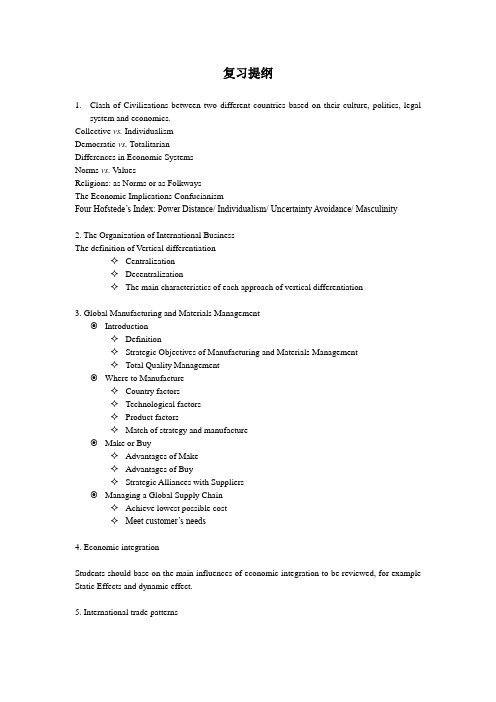
复习提纲1.Clash of Civilizations between two different countries based on their culture, politics, legalsystem and economics.Collective vs. IndividualismDemocratic vs. TotalitarianDifferences in Economic SystemsNorms vs. ValuesReligions: as Norms or as FolkwaysThe Economic Implications ConfucianismFour Hofstede’s Index: Power Distance/ Individualism/ Uncertainty Avoidance/ Masculinity2. The Organization of International BusinessThe definition of Vertical differentiation✧Centralization✧Decentralization✧The main characteristics of each approach of vertical differentiation3. Global Manufacturing and Materials Management∙Introduction✧Definition✧Strategic Objectives of Manufacturing and Materials Management✧Total Quality Management∙Where to Manufacture✧Country factors✧Technological factors✧Product factors✧Match of strategy and manufacture∙Make or Buy✧Advantages of Make✧Advantages of Buy✧Strategic Alliances with Suppliers∙Managing a Global Supply Chain✧Achieve lowest possible cost✧Meet customer’s needs4. Economic integrationStudents should base on the main influences of economic integration to be reviewed, for example Static Effects and dynamic effect.5. International trade patternsReview these five fundamental notions:Franchising, FII, Licensing, greenfield strategy, Countertrade6. International HRMReview the efficiently work of expatriate manager驻外经理in foreign country. A few points/questions can be considered (but not restrict to these) for the review of expatriate issues, which is identified as an important part of the chapter of global HRM (please refers to the PPT slides):First of all, distinguishing the Hofstede’s national dimensions. And identify if there are any differences between China and the UK(or USA) in relation to the national cuture.Secondly, identifying the reasons of expatriate failure and explore the fact that why so many expatriates expeirence failure.Thirdly, telling what are the capabilities that expatriate should acquire in order to qualify for working in multinational subsidiary.Fourthly, concluding what are the factors HR managers should consider when selecting expatriates.7. Foreign exchange marketThe functions of the Foreign Exchange Market: covert currencies and reducing risk.1)the reasons firms need to convert currencies;2)how to use forward exchanges or swaps to hedge against exchange rate changes.8. Financial Management in the International BusinessThe means of moving money across borders to attain efficiencies and reduce taxes.Global money management techniquesHow to use payments netting system to transfer subsidiary capital.How to use financial measures to manage exchange risk.一、Clash of Civilizations between two different countries based on their culture, politics, legal system and economics.1、possible question:what is Collectivism and. Individualism? What is their differences?Collectivism refers to a political system that stressed the primacy of collective goals over individual goals. When collectivism is emphasized, the needs of society as a whole are generally viewed as being more important than individual freedoms. In such circumstances, an individual′s right to do something may be restricted on the grounds that it runs counter to “the good of society”or to “the common good.” On th e contrary, individualism refers to a political system that stresses the primac fo individual goals over the collective goals, it emphasize the individual development and individual rights. So this system emphasize much on individual rights protection.Main differences: A. collectivism is the core of morality of Socialism while individualism is the core of morality of capitalism.2、possible question: what is the Democratic and Totalitarian?Democracy and totalitarianism are at different ends of a political dimension. Democracy refers to a political system in which government is by the people, exercised either directly or through elected representatives. Totalitarianism is a form of government in which one person or political party exercises absolute control over all spheres of human life and prohibits opposing political parties.3、possible question:what is the differences in different Economic Systems?It should be clear that political ideology and economic systems are connected. In countries where individual goals are given primacy over collective goals, we are more likely to find free market system. In contrast, in countries where cillective goals are given preeminence, the state may have taken control over many enterprises, market in such countries are likely to be restricted rather than free. We can identify tree broad types of economic ststems——a market economy, a command economy, and a mixed economy.In a pure market economy, all productive activities are privately owned, as opposed to owned by the state. The goods and services that a country produces are not planed by anyone. Production is determined by the interaction of supply and demand and signaled to producers through the price system. For a market to work in this manner, suppply must not be restricted. A supply restriction occurs when a single firm monopolizes a market. In such circumstances, rather than increase output in response to increased demand, a monopolist might restrict output and let prices rise. Given the dangers inherent in monopoly, the role of government in a market economy is to encourage vigorous free and fair competition between private producers.In a pure command economy, the government plans the goods and services that a country produces, the quantity in which they are produced, and the prices at which they are sold. Consistent with the collectivist ideology, the objective of a command economy is for government to allocate resource for “the good of society.” In addition, in a pure command economy, all businesses are state owned, the rationale being that the government can then direct them to make investments that are in the best interests of the nation as a whole rather than in the interests of private individuals. While the objective of a command economy is to mobilize economic recouces for the public good, the opposite seems to have occurred. In a conmmand economy,state-owned enterprises have little incentive to controlcosts and be efficient because they can not go out of business.Between market economies and command economies can be found mixed economies. In a mixed economy, certain sectors of the economy are left to private ownship and free market mechanisms while other sectors have signifiant state ownship and government planning. In a mixed economy, governments also tend to take over troubled firms they consider to be vital to national interests.4、possible question: what is norms and values?Norms are the social rules that govern people′actions towad on another. Norms can be subdivided further into two major categories: folkways and mores. Folkways are the routine conventions of everyday life. Generally, folkways are actions of little moral significance. Rather, they are social conventions concerning things such as the appropriate dress code in a particular situation, good sicial manners, eating with the correct utensils, neighborly behavior, and the like. Mores are norms that are seen as central to the functioning of a society and to its social life. They have much greater significance than folkways. Accordingly, violating mores can bring serious retribution. Mores include such factors as indictments against theft, adultery, incest, and cannibalism.Values form the bedrock of a culture. They provide the context within which a society′s norms are estabilshed and justified. They may include a society′s attitudes toward such concepts as individual freedom, democracy, truth, justice, honesty, loyalty, society obligations, collective responsibility, the role of women, love, sex,marriage, and so on. Values are not just abstract concepts, they are invested with considerable emotional significance. Values also often are reflected in the political and economic systems of a society.5、possible question: what is religions?Religion may be defined as a system of shared beliefs and rituals that are concerned with the realm of the sacred. 关于norms和folkways上面已说6、possible question: what is the Economic Implications Confucianism?This basis thesis is that confucian ethics may help explain the economic success of China, Japan, and South Korea because it lowers the costs of doing business in those countries. In this regard, three values central to the confucian system of ethices are of particular interest: loyalty, reciprocal obligations, and honesty in dealings with others.In confucian thought, loyalty to one′s superiors is regarded as a sacred duty. In modern organizetions based in confucian cultures, the loyalty that binds employees to the heads of their organization can reduce the conflict between management and labor that we find in more class-conscisous societes. Cooperation between management and labor can be achieved at a lower cost in a culture where the value system emphasizes the virtue fo loyalty.The concept of reciprocal obligations is important. Confucian ethics stess that superiors are obliged to reward the loyalty of their subordinates by betowing blessings on them. If these “blessings” are not forthcoming, then neither will be the loyalty. This confucian ethic si central to the Chinese concept of GUANXI, which refers to relationship networks supported by reciprocal obligations. GUANXI is an important mechanism ofr building long-term business relationships and getting business done in China.A third concept found in confucian ethics is the importance attached to honesty. Confucian thinkers emphasize that, although dihonest behavior may yield short-term benefits for thetransgressor dishonesty does not pay in the long run. The importance attached to honesty has major economic implications. When companies can trust each other not to break contractual obligations, the costs of doing business are lowered. For instance, expensive lawyers are not needed to resolve contract disputes.7、what is Four Hofstede’s Index: Power Distance/ Individualism/ Uncertainty Avoidance/ Masculinity?Hofstede′s pow er distance dimension focused on how a society deals with the fact that people are unequal in physical and intellectual capabilities. According to Hofstede, high power distance cultures were found in countries that let inequalities grow over time into inequalities of power and wealth. Low power distance culture were found in societies that tried to play down such inequalites as much as possible.The individualism versus collectivism dimension focused on the relationship between the individual and his or her fellows. In individualistic societies, the ties between individuals were loose and individual achievement and freedom were highly valued. In socities where collectivism was emphasized, the ties between individuals were tight. In such societies, people were born into collectives, such as extended families, and everyone was supposed to look after the interest of his or her collective.H ofsted′s uncertainty avoidance dimension measured the extent to which different cultures socialized their members into accepting ambiguous situations and toleraing uncertainty. Members of high uncertainty avoidance cultures placed a premimu on job security, careerpatterns, retirement benefits, and so on. They also had a strong need for rules and regulations. Manater was expected to issue clear instuctions, and subordinates′initiatives were tightly controlled. Lower uncertainty avoidance cultures were characterized by agreater rediness to take risks and less emotional resistance to change.Hofstede′s masculimity versus feimininity dimension looked at the relationship between gender and work roles. In masculine cultures, sex roles were shareply differentiated and traditional “masculine values,”such as achievement and the effective eercise of power, determined cultural ideals. In feminine cultures, sex roles were less sharply distinguished, and little differentiation was made between men and women in the same job.二、The Organization of International Business1、possible question: what is the definition of Vertical differentiation?Vertical differentiation determines where in its hierarchy the decision-making power is concentrated. The main two approaches are centralization and decentralization.2、possible question: what is centralization and decentralization? What is the main characeristics of two approaches?Centralization is a kind of organizaion structure that top managers or general company of a group have most rights to make final decisions. While decentralization is the other kind of organization structure that first-line managers or contralled companies of a group have most rights to make final decisions but the top managers just have right to make decision related to he whole group.The main characteristics of centralizatioin are that, first it can facilitate coordination, such as this coordination might be achieved by centralizing production scheduling at the firm′s head office, and so on. Second, centralization can help ensure that decision s are consistent with organizational objectives. Centralization of inmortant decisions minimizes the chance of thisinconsistency occurring. Third, by concentrating power and authority in one individual or a management theam, centralization can give top-level managers the means to bring about needed major organizational changes. Forth, centraliaiton can avoid the duplication of activities that occurs when various subunits within the organization carry on similar activities. Finally, top management can become overburdened when dicision-making authority is centralized.The main characteristics of decentralization are that, first decentralizaiton fives topo management time to focus on critical issues by delegating more routine issues to lower-level managers second, motivational research favors decentralization. Third, decentralization permits greater flexibilit——more rapid response to environmental change. Forth, decentralization can result in better dcisions. In a decentralized structure, decisions are made closer to the spot by individuals who have better information than managers several levels up in a hierarchy. Fifth, decentralization can increase control. The more responsibility subunit managers have for decisions that impact subunit performance, the fewerexcuses they have for poor performance.三、Global Manufacturing and Materials Management1、Possible question:what is the definition of Materials Management? What is the strategic Objectives of Manufacturing and Materials Management? What is Total Quality Management?Materials Management is the activity that controls the transmission of physical materials through the value chain, from procurement through production and into distribution. Additionally, logistics is the procurement and physical transmission of material through the supply chain, from suppliers to customers.The strategic objectives of manufacturing and materials management are first to Lower costs. Dispersing production activities to various locations around the globe where each activity can be performed most efficiently can lower cost. Costs can also be cut by managing he global supply chain efficiently so as to better match supply and demand. Second is to increase product quality by eliminating defective products from both the supply chain and the manufacturing process. Improved quality control reduces costs by increasing productivity, lowering rework and scrap costs associated with defective products and reducing the warranty costs and time associated with fixing defective products. Third is to accommodate demands for local responsiveness. Demands for local responsiveness create pressures to decentralize production activities to the major national or regional markets in which the firm does business or to implement flexible manufacturing processes that enable the firm to customize the product coming out of a factory according to the market in which it is to be sold. Finally is to be able to respond quickly to shifts in customer demand. In recent years, time-based competition has grown more important. When consumer demand is rone to large and unpredictable shifts, the firm that can adapt most quickly to these shifts will gain an advantages.The total quality management is (有多种定义)TQM is a philosophy advocating four basic principles (i) intense focus on customer satisfaction, (ii) accurate measurement of activities, (iii) continuous improvement of products and processes, and (iv) empowerment of people. (Noori & Radford, 1995) ;TQM is a management philosophy that builds a customer driven, learning organization dedicated to total customer satisfaction through continuous improvement in the effectiveness and efficiency of the organization and its processes. (Corrigan, 1995) ; TQM is a system of management that gauges a company’s dedication to consistentimprovement and a sincere effort to serve its customers with what they expect all the time. It is a philosophy of management to achieve greater productivity and a total awareness of quality as an increasingly important element in competitiveness (Gould, 1992).TOTAL Everyone and everything that we doQUALITY Giving the customer what they expect all the time MANAGEMENT The way we act and operate our policies andprocedures, and our training and instruction to all of ouremployeesTotal quality management is defined as both a philosophy and a set of guiding principles that represent the foundation of a continuously improving organization. It is the application of quantitative methods and human resources to improve all the processes within an organization and exceed customer needs now and in the future. TQM integrates fundamental management techniques, existing improvement efforts, and technical tools under a disciplined approach. TQM consists of:• Total: Made up of the whole• Quality: Degree of excellence a product or service provides• Management: Act, art, or manner of handling, controlling, directing, etc. Therefore, total quality management is the art of managing the whole to achieve excellence.2、possible question: what should be considered when we dicide where to manufacture.The main factors we should consider are Country factors, Technological factors and Product factors.The country fators include relative factor costs, political economy, national culture, trade barriers and exchange rates. So other things equal, a firm should locate its various manufacturing activities where the economic, political, and cultural conditions, including relative factor costs, are conducive to the performance of those activities. Also inmortant in some industries is the presence of global concentrations of activities at certain locations.The technological factors include fixed costs, minimum efficient scale and flexible manufacturing. In some cases the fixed costs of setting up a production plant are so high that a firm must serve the world market form a single location ofr from a very few locations. Conversely, a relatively low level of fixed costs can make it economical to preform a particular activity in several locations at once. As for minimum efficient scale, the larger the minimum efficient scale of a plant relative to total global demand, the greater the argument for centralizing production in a single location or a limited number of locations. If lower, several locations. As for flexible manufactruing technologies allow the company to produce a wider variety of end products at a unit cos that at one time could be achieved only through the mass peoduction of a standardized output. Summary: other things being equal, when fixed costs are substantial, the minimum efficient scale of production is high, flexible manufacturing technologies are available, the argument for concentrating production at a few choice locations are strong.The product factors include value to weight ratio (which influence transportation costs) and whether product serves universal needs.3、possible question: what is possible strategy to locate where to manufacture? How should the strategy and manufacture match?Two possible strategy to locate where to manufacture are concentration and decentralization. When Differences in political economy are substantial; Differences in culture are substantial; Differences in factor costs are substantial; Trade barriers are few; Exchange rates are stable; Fixed costs are high; Minimum efficient scale is high; Flexible manufacturing technology is available; Value-to-weight ration is high; Serves universal needs are required, we should choose concentrated stragetic.As for match of strategy and manufacture, 见PPT P174、possible question: what is the advantage of make and what is the advantage of buy?The advantages of make are lower costs, facilitating specialized investments, proprietary product technology protection and improved scheduling. Lower cost: it may pay a firm to continue manufacturing a product or component part in-house if the firm is more efficient at that production activity than any other enterprise, such as Boeing decided to outsource the production of some component prats but keep the design and final integration of aircraft for it is more efficient at design and final intergration. Facilitating specialized investments: in general, we can predict that when substantial investments in specialized assets are required to manufacture a component, the firm will prefer to make the component internally rather than contract it out to a supplier. Protecting proprietary product technology: the firm would not want competitors to get this technology. Improving scheduling: production cost saving result from it makes planning, coordination, dand scheduling of adjacent processes easier.The advantages of buy are strategic flexibility, lower costs and help the firm capture orders from international customers. Strategic flexibility: the firm can maintain its flexibility, switching orders between suppliers as circumstances dictate. This is particularly important internationally, where changes in exchange rates and trade barriers can alter the attractiveness of supply sources. Lower costs: although making is often undertaken to lower costs, it may have the opposite effect. Outsourcing may lower the firm′s cost structure. The firm that sources from independent suppliers has fewer subunits to control and buying component parts from independent fuppliers avoids the bureaucratic inefficiencies and resulting costs that can arise when firms vertically integrate backward and produce their own components, and also avoid increse in roganizational complexity.5、possible question: how to managing a global supply chain?Logistics encompasses the activities necessary to get materials from suppliers to a manufacturing facility, through the manufactruing process, and out through a distribution system to the end user. In the international business, the logistics function manages the global supply chain. The twin objectives of logistics are manage a firm′s global supply chain at the lowest possible cost and in a way that best serves customer needs. JIT-just in time system is to economize on inventory holding costs by having materials arrive at a manufacturing plant just in time to enter the production process and not before. The major cost saving comes from speeding up inventory turnover, which reduces inbentory holding costs. The information technology also play a crucial role in modern materials management as it can enable a firm to optimize its production scheduling according to when components are expected to arrive.四、Economic integration五、International trade patterns1、what is the fundamental notions of Franchising, FII, Licensing, greenfield strategy, Countertrade?Licensing: a licensing agreement is an arrangement whereby a licensor grants the rights to intangible property to another entity for a specified period, and in return, the licensor receives a royalty fee from the licensee. The advantage of licensing is that, firstly the firm does not have to bear the development costs and risks associated with opening a foreign market. In addition, licensing can be attractive when a frm is unwilling to commit substantial financial resources to an unfamiliar or politically volatile foreign market. The final advantage is licensing is frequently used when a firm posesses some intagible property that might have business applications, but it does not want to develop those applications itself. Licensing has three serious problems, first is it does not give a firm that tight control over manufacturing, marketing, and strategy that is required for realizing experience curve and location economies. The second is competing in a global market may require a firm to coordinate strategic moves across countries by using profits earned in one country to support competitive attacks in another. The third problem is licensing is a risk associated with licensing technological know-how to foreign companies.Franchising: franchising is similar to licensing, it is basically a specialized form of licensing in which the franchiser not only sells intangible property to the franchisee but also insists that the franchisee agree to abide by strict rules as to how it does business. The advantage of franchising is by using a franchising strategy, a service firm can build a global presence quickly and at a relatively low cost and risk, as McDonald′s has. The disadvantage is franchising may inhibit the firm′s ability to take profits out of one country to supprot competitive attacks in another. A m ore significant diadvantage of franchising is hard to control quality.Greenfield strateagy is a firm can establish a wholly owned subsidiary in a country by building a subsidiary from the ground up. The big advantage of establishing a greenfield venture in a foreign cuntry is that it gives the firm a much greater ability to build the kind of subsidiary company that it wants. The disadvantage is that greenfield wentures are slowr to establish, they are also rsky.Countertrade is an alternative means of structuring an international sale when conventional means of payment are difficult, costly, or nonexistent. Countertrade denotes a whole range of barterlike agreements, its principle is to trade goods and services for other goods and services when they can not be traded for money. With its roots in the simple trading of goods and services for other goods and services, countertrade has evolved into a diverse set of activities that can be categorized as five ditinct types of trading arrangements: barter, counterpurchase, offset, switch trading, and compensation or buyback. Many countertrade deals involve not just one arrangement, but elements of two or more. countertrade′s main advantage is that it can five a firm a way to finance an export deal when other means are not available. In addition, the government of a country to which a firm is exporting goods or services may require a countertrade agreement. However, the drawbacks of countertrade agreements are substantial. Countertrade contracts may involve the exchange ouf unusable or poor-quality goods that firm can not dispose of profitably. In addition, even if the goods it receives are of high quality, the firm still needs to dispose of them profitably. So given these drawbacks, countertrade is most attractive to large, diverse multinational enterprises that can use their worldwide network of contacts to dispose of goods acquired in countertrading.。
【精品】国际贸易复习大纲19页PPT

28、目标的坚定是性格中最必要的力 量泉源 之一, 也是成 功的利 器之一 。没有 它,天 才也会 在矛盾 无定的 迷径中 ,徒劳 无功。- -查士 德斐尔 爵士。 29、困难就是机遇。--温斯顿.丘吉 尔。 30、我奋斗,所以我快乐。--格林斯 潘。
41、学问是异常珍贵的东西,从任何源泉吸 收都不可耻。——阿卜·日·法拉兹
42、只有在人群中间,才能认识自 己。——德国
43、重复别人所说的话,只需要教育; 而要挑战别人所说的话,则需要头脑。—— 玛丽·佩蒂博恩·普尔
44、卓越的人一大优点是:在不利与艰 难的遭遇里百折不饶。——贝多芬
45、自己的饭量自己知道。——苏联
国际商务复习大纲

掠夺性定价:以价格为竞争武器,将较弱的竞争者逐出一个国家的市场。
!
多点定价策略:两个以上的跨国公司在两个以上的国家市场彼此竞争。
!
经验曲线定价:开始低价,获得先发成本优势。
6、跨部门研发小组:
!
重量级人物领导
!
各部门必须有至少一名代表
!
尽可能在一处工作,增加亲密感方便沟通
!
明确的计划和目标
!
制定自己的沟通及冲突解决程序
十六、全球制造与原材料管理
1、原材料管理:是对物质材料通过整个价值链的传输过程——从采购、生产到分销的控制活动。
2、在哪里制造的影响因素:
!
国家因素(区域外部性;贸易壁垒;汇率变动)
!
技术因素(固定成本;最小效率规模;柔性制造与大规模定制)
!
产品因素(价值重量比;服务世界通用需要)
国家因素 政治经济差别 文化差别 要素成本差别 贸易壁垒
!
伊斯兰教:强调履行契约责任、信守诺言,决不欺骗。节俭。不剥削。不收受利息。
!
印度教:苦行文化,种姓制度。
!
儒教:忠、信、义。绝对的责任。降低管理成本。
十二、国际企业的战略
1、通过全球扩张来盈利
!
区位经济(创建全球网络)
!
经验效应(学习效应,规模经济,战略意义)
!
!
经验曲线:在产品寿命周期内所观察到的生产成本有规律的下降。
!
!
技术授权:(是指一项协议,规定在某一特定时间内,许可方把无形资产授予另一个实体,收取一定
的许可使用费)
!
!
优点:企业不必承担开发国外市场的费用和风险;规避技术壁垒;不想开发无形资产的应用价
值。
国际商务备考

国际商务备考
国际商务备考需要掌握以下知识点:
1. 国际贸易政策和法规:需要了解各国的贸易政策和法规,包括贸易壁垒、关税、贸易协定等。
2. 国际贸易环境:了解国际贸易所处的经济、政治、文化等环境,包括国际货币体系、文化差异和语言障碍等。
3. 国际市场营销:掌握国际市场营销的策略和技巧,包括调研、定位、品牌推广等。
4. 国际贸易谈判和管理:了解谈判策略、技巧及各种管理技巧,包括合同管理、项目管理等。
5. 国际物流和供应链管理:了解国际物流和供应链管理的流程和技术,包括货运、仓储、供应链协调等。
6. 知识产权和贸易保护:了解知识产权和贸易保护的重要性和方式,包括商标、专利、版权等。
7. 跨文化沟通和管理:了解跨文化沟通和管理的挑战和方法,包括文化差异的
影响和解决技巧。
以上是一些国际商务备考的知识点,需要建立扎实的理论基础并且多做实践才能够更好地掌握这些知识点。
国际商务资格考试复习要点
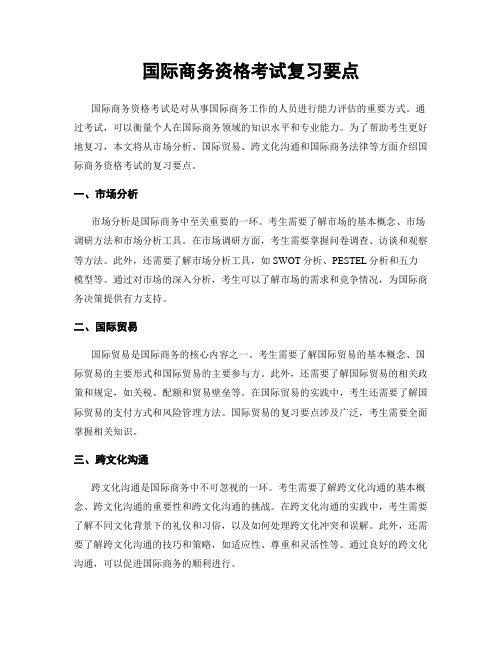
国际商务资格考试复习要点国际商务资格考试是对从事国际商务工作的人员进行能力评估的重要方式。
通过考试,可以衡量个人在国际商务领域的知识水平和专业能力。
为了帮助考生更好地复习,本文将从市场分析、国际贸易、跨文化沟通和国际商务法律等方面介绍国际商务资格考试的复习要点。
一、市场分析市场分析是国际商务中至关重要的一环。
考生需要了解市场的基本概念、市场调研方法和市场分析工具。
在市场调研方面,考生需要掌握问卷调查、访谈和观察等方法。
此外,还需要了解市场分析工具,如SWOT分析、PESTEL分析和五力模型等。
通过对市场的深入分析,考生可以了解市场的需求和竞争情况,为国际商务决策提供有力支持。
二、国际贸易国际贸易是国际商务的核心内容之一。
考生需要了解国际贸易的基本概念、国际贸易的主要形式和国际贸易的主要参与方。
此外,还需要了解国际贸易的相关政策和规定,如关税、配额和贸易壁垒等。
在国际贸易的实践中,考生还需要了解国际贸易的支付方式和风险管理方法。
国际贸易的复习要点涉及广泛,考生需要全面掌握相关知识。
三、跨文化沟通跨文化沟通是国际商务中不可忽视的一环。
考生需要了解跨文化沟通的基本概念、跨文化沟通的重要性和跨文化沟通的挑战。
在跨文化沟通的实践中,考生需要了解不同文化背景下的礼仪和习俗,以及如何处理跨文化冲突和误解。
此外,还需要了解跨文化沟通的技巧和策略,如适应性、尊重和灵活性等。
通过良好的跨文化沟通,可以促进国际商务的顺利进行。
四、国际商务法律国际商务法律是国际商务中不可或缺的一部分。
考生需要了解国际商务法律的基本概念、国际商务合同和国际商事仲裁等方面的内容。
在国际商务法律的实践中,考生需要了解国际商务纠纷的解决机制和国际商务法律的适用原则。
此外,还需要了解国际商务法律的相关条款和规定,如国际贸易的INCOTERMS和国际商事合同的规范等。
通过对国际商务法律的深入学习,可以为国际商务的合法运作提供保障。
综上所述,国际商务资格考试的复习要点涉及市场分析、国际贸易、跨文化沟通和国际商务法律等方面。
国际贸易理论期末考试复习提纲知识点
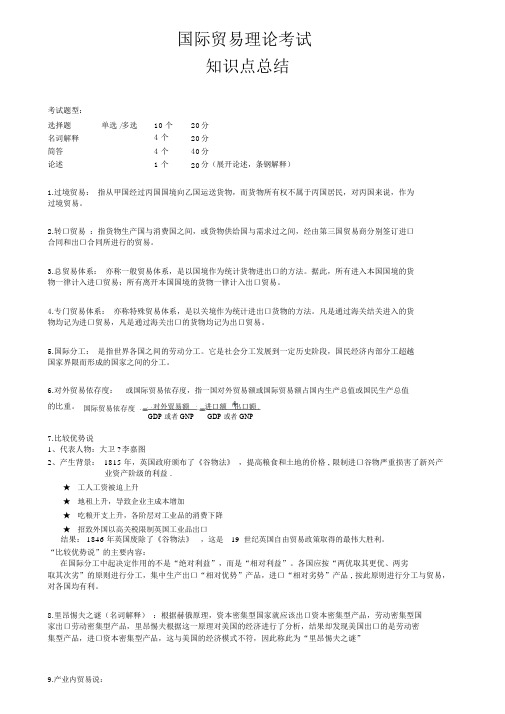
国际贸易理论考试知识点总结考试题型:选择题单选 /多选10 个20分名词解释 4 个20分简答 4 个40分论述 1 个20分(展开论述,条钢解释)1.过境贸易:指从甲国经过丙国国境向乙国运送货物,而货物所有权不属于丙国居民,对丙国来说,作为过境贸易。
2.转口贸易:指货物生产国与消费国之间,或货物供给国与需求过之间,经由第三国贸易商分别签订进口合同和出口合同所进行的贸易。
3.总贸易体系:亦称一般贸易体系,是以国境作为统计货物进出口的方法。
据此,所有进入本国国境的货物一律计入进口贸易;所有离开本国国境的货物一律计入出口贸易。
4.专门贸易体系:亦称特殊贸易体系,是以关境作为统计进出口货物的方法。
凡是通过海关结关进入的货物均记为进口贸易,凡是通过海关出口的货物均记为出口贸易。
5.国际分工:是指世界各国之间的劳动分工。
它是社会分工发展到一定历史阶段,国民经济内部分工超越国家界限而形成的国家之间的分工。
6.对外贸易依存度:或国际贸易依存度,指一国对外贸易额或国际贸易额占国内生产总值或国民生产总值的比重。
国际贸易依存度对外贸易额进口额出口额GDP 或者 GNP GDP 或者 GNP7.比较优势说1、代表人物:大卫 ?李嘉图2、产生背景:1815 年,英国政府颁布了《谷物法》,提高粮食和土地的价格 , 限制进口谷物严重损害了新兴产业资产阶级的利益 .★工人工资被迫上升★地租上升,导致企业主成本增加★吃粮开支上升,各阶层对工业品的消费下降★招致外国以高关税限制英国工业品出口结果: 1846 年英国废除了《谷物法》,这是19世纪英国自由贸易政策取得的最伟大胜利。
“比较优势说”的主要内容:在国际分工中起决定作用的不是“绝对利益”,而是“相对利益”。
各国应按“两优取其更优、两劣取其次劣”的原则进行分工,集中生产出口“相对优势”产品,进口“相对劣势”产品 , 按此原则进行分工与贸易,对各国均有利。
8.里昂惕夫之谜(名词解释):根据赫俄原理,资本密集型国家就应该出口资本密集型产品,劳动密集型国家出口劳动密集型产品,里昂惕夫根据这一原理对美国的经济进行了分析,结果却发现美国出口的是劳动密集型产品,进口资本密集型产品,这与美国的经济模式不符,因此称此为“里昂惕夫之谜”9.产业内贸易说:1、代表人物 :格鲁贝尔、保罗?克鲁格曼,(08诺贝尔得主)2、相关概念:产业间贸易:各国不同产业之间的产品交换.产业内贸易:各国同一产业内的同类产品的交换.( 按 SITC, 至少前 3 位数相同的产品同时出现在一国的进出口中)主要内容:产业内贸易的形成原因是:同类产品的异质性(重要基础);规模经济收益递增(重要成因);各国经济发展水平(制约因素)。
- 1、下载文档前请自行甄别文档内容的完整性,平台不提供额外的编辑、内容补充、找答案等附加服务。
- 2、"仅部分预览"的文档,不可在线预览部分如存在完整性等问题,可反馈申请退款(可完整预览的文档不适用该条件!)。
- 3、如文档侵犯您的权益,请联系客服反馈,我们会尽快为您处理(人工客服工作时间:9:00-18:30)。
Merging of historically distinct and separate national markets into one huge global market place. refers to the sourcing of goods and services from locations around the globe to take advantage of national differences in the cost and quality of factors of production (such as labor, energy, land, and capital).
The total cumulative value of foreign investment.
The flow of FDI-The amount of FDI undertaken over a given time period(normally a year)
(历史上独特和独立的国家市场合并成一个巨大的全球市场。
是指采购的商品和服务在全球各地充分利用国家的生产要素(如劳动力,能源,土地,资本)的成本和质量的差异的位置。
总累计值的外国投资。
流动的外国直接投资的金额进行的外国直接投资在给定的时间内(通常为一年))
the degree to which they emphasize collectivism as opposed to individualism
the degree to which they are democratic or totalitarian
market economy\command economy
(他们在何种程度上强调集体主义,反对个人主义
他们在何种程度上是民主或极权主义
市场经济\命令经济)
common law/civil law, 各自国家
不同法律制度在合约制定、专利保护上的特点。
.country’s gross national income per head of population (GNI)
Adjust GNI per capita by purchasing power
Amartya Sen的Human Development Index (HDI)人文发展指数
Evaluation of overall attractiveness
政治、经济、法律、文化环境可能导致的国际商务风险?跨国购并风险
3Identify the forces that lead to differences in social culture
Norms、V alues、Mores对应的英文释义
教育和一国国家竞争力、营销策略的关系
3.6.1Geert Hofstede’ s framework ,四个维度的定义,如何评价,其指导性作用,看幻灯片
Understand how differences in social culture influence value in the workplace.
3.8 implication for business,精读,特别是3.8。
2 结合英文幻灯片,culture and competitive advantage. Cross cultural literacy
第5章
New trade theory:_scales of economie, first mover advantage, trade pattern, trade gain, 其对政府政策含义。
波特的国家竞争优势理论,图5-5,各种属性之间的关系,政府政策含义。
课后习题第6题
第6章,基本定义:FDI\MNE\greenfield investment,gross fixed capital formation\Oligopoly
Acquiring or merging with an existing firm in the foreign country: minority, majority, full outright take Flow of FDI : the amount of FDI undertaken over a given time period ( normally a year)
Stock of FDI: the total accumulated value of foreign-owned assets/ foreign investments at a given time) The theory of why FDI
Eclectic Paradigm(John Dunning_location specific advantage
Strategic behavior
7.6.1 the theory of FDI FDI 理论
Important theory
1、Location implications——解决FDI区位的选择
------Dunning’s theory: The eclectic paradim-explain the direction of FDI, not why firms prefer FDI?
2。
When do we need to do FDI?
------A decision framework
课后习题4
11章:图11-6战略适合框架、作为一个价值链的企业(图11-4)
企业从全球扩张的获利途径(关键名词:location economies,core competence, experience curve, learning effect)成本压力,对当地需求响应的压力的来源。
四种战略的优缺点、在图11-9中的位置,不同战略的管理构架特点和所利用的获利途径。
如何设计合理的联盟结构。
批判性思考题第2题和第3题。
12章
12.2 三种基本决策。
12.3 turnkey projects, license, franchising、joint ventures, wholly owned subsidiary对应的英文解释。
表12-1 各种进入模式优缺点。
12.4.1 和12.4.2 核心竞争力和成本降低压力对进入模式的影响。
重点:对收购的赞成和反对、收购失败的原因、如何降低失败风险。
生地投资优缺点、企业如何选择生地投资还是收购。
批判性思考题:4
14章(1)14.3 where to locate, 柔性制造技术、最小效率规模、
14.5 外包生产:自制或外购决定(专门资产名词)
15章:
15.4 产品属性,影响不同国家产品差异有哪些方面
15.5分销策略:国家间差异,如何选择。
(集中和分散的零售体系英文释义)
15.6 沟通策略:影响国际沟通效果的三个潜在关键变数,会判断。
其中,源头影响和原产地影响释义。
企业如何选择推式策略和拉式策略。
15.7 实现价格歧视的两个必需条件。
影响一特定国家的产品需求弹性因素。
战略定价的三种形式比较,对应的英文释义。
16章,
表16-1人员配备策略
选择:10分
名词释义:10分
图示(12)
简答(32)
方案设计和解决问题(18)
案例分析(18)。
